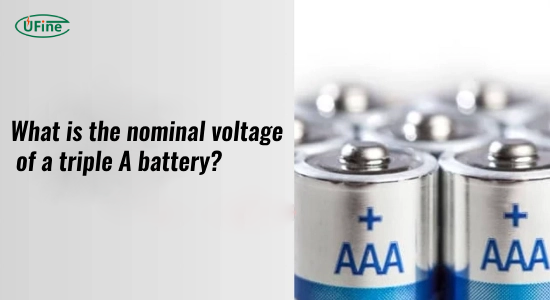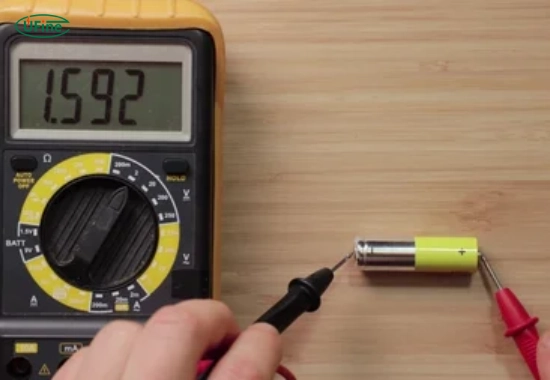
- Part 1. What is the voltage of a triple a battery?(AAA Battery Voltage Explained)
- Part 2. How does battery chemistry affect aaa battery voltage?
- Part 3. How many volts do three triple a batteries produce? (AAA Voltage in Series)
- Part 4. How to test aaa battery voltage with a multimeter?
- Part 5. What factors affect aaa battery voltage performance?
- Part 6. Common applications for triple a battery voltage
- Part 7. Can I mix different aaa battery voltages?
- Part 8. How Long Do Triple A Batteries Last?
- Part 9. Can I recharge triple A alkaline batteries?
- Part 10. FAQs about AAA battery voltage
- Part 11. Conclusion: Understanding aaa battery voltage for better performance
Understanding the AAA battery voltage is key to ensuring your devices perform reliably. Whether you’re powering a remote, camera, or sensor, knowing how many volts are in a triple A battery helps you choose between 1.5V alkaline and 1.2V rechargeable NiMH options. This guide includes a full AAA battery voltage chart, explains testing methods, and answers common questions to help you make the right choice in 2025.
Voltage of Triple A Battery: Key Facts
Quick Answer: The standard voltage of a triple A (AAA) battery is 1.5 volts for alkaline and lithium types, while rechargeable NiMH batteries provide 1.2 volts. This voltage directly impacts device compatibility and runtime.
Part 1. What is the voltage of a triple a battery?(AAA Battery Voltage Explained)
Quick Answer: The standard voltage of a triple A battery is 1.5 volts for alkaline and lithium types, and 1.2 volts for rechargeable NiMH types. Actual AAA battery voltage range is 1.2–1.8V depending on chemistry and charge.
| Battery Type | Nominal Voltage | Voltage Range | Rechargeable |
|---|---|---|---|
| Alkaline AAA | 1.5V | 1.5–1.6V | No |
| Lithium AAA | 1.5V | 1.5–1.8V | No |
| NiMH AAA | 1.2V | 1.2–1.4V | Yes |
This table clearly shows why most devices are designed to operate safely within the AAA battery voltage range of 1.2V to 1.6V.
Voltage chart:
- Alkaline AAA: 1.5V — fresh 1.5–1.6V, depleted < 1.2V
- Lithium AAA: 1.5V — stable performance, good for high-drain devices
- NiMH (rechargeable) AAA: 1.2V — fully charged ≈ 1.4V, rechargeable
Understanding these nominal voltages and operating ranges helps choose the right AAA battery for device compatibility and runtime performance.
For more detailed battery comparisons including NiCd and device compatibility, see Part 2 table.
Part 2. How does battery chemistry affect aaa battery voltage?
The chemical composition directly determines the AAA battery voltage and capacity. Different materials yield different voltages and discharge behaviors.
| Battery Type | Nominal Voltage | Voltage Range | Rechargeable | Best For |
|---|---|---|---|---|
| Alkaline | 1.5V | 1.5-1.6V (fresh) 1.2V (dead) |
No | Remote controls Wall clocks |
| Lithium | 1.5V | 1.5-1.8V | No | Digital cameras LED flashlights |
| NiMH | 1.2V | 1.2-1.4V | Yes | Gaming controllers RC toys |
| NiCd | 1.2V | 1.0-1.2V | Yes | Emergency devices Medical equipment |
Each chemistry reacts differently under load. For instance, NiMH rechargeable AAA batteries provide stable voltage during use, while alkaline voltage gradually drops. This difference is essential when selecting batteries for devices requiring constant voltage, like sensors or medical tools.
Impact of Chemistry on Performance
- Alkaline Batteries: These are the most common type of AAA batteries used in everyday devices. They have a stable output of 1.5 volts and are non-rechargeable.
- Lithium Batteries: Known for their longevity and consistent performance, lithium AAA batteries also provide 1.5 volts and can handle higher-drain applications better than alkaline types.
- NiMH Batteries: While these rechargeable batteries offer lower nominal voltage (1.2 volts), users can recharge them multiple times, making them more cost-effective in the long run.
Understanding these characteristics allows users to choose the right type of battery based on their specific needs.
Part 3. How many volts do three triple a batteries produce? (AAA Voltage in Series)
When connecting batteries in series, total voltage equals the sum of individual voltages. Therefore, three AAA batteries deliver approximately 4.5 volts (1.5V × 3). For NiMH types, the total is about 3.6V (1.2V × 3).
Total Voltage Calculation
- Total Voltage=Number of Batteries×Voltage per Battery
For three AAA batteries:
- Total Voltage=3×1.5V=4.5V
This principle applies to any number of batteries connected in series, making it essential for powering devices that require higher voltages.
Part 4. How to test aaa battery voltage with a multimeter?
Checking AAA battery voltage is easy with a digital multimeter. This quick test helps identify weak or depleted batteries before replacing them.
Checking the voltage of an AAA battery is straightforward and can be done using a voltmeter or multimeter:
Steps to Measure Voltage
- Gather Your Tools: Obtain a digital multimeter or voltmeter.
- Set Up the Voltmeter: Turn on your device and set it to measure DC voltage.
- Connect Probes: Place the red probe on the positive terminal and the black probe on the battery’s negative terminal.
- Read the Display: The multimeter will display the battery’s current voltage.
This simple process helps determine whether your batteries are still functional or need replacing.
AAA Battery Voltage Chart (Condition Guide)
| Voltage Reading | Condition |
|---|---|
| 1.6V+ | Fresh / New |
| 1.3–1.5V | Good / 50%+ |
| 1.2V or below | Replace / Recharge |
Part 5. What factors affect aaa battery voltage performance?
Several factors can influence the actual output voltage of AAA batteries during use:
- Discharge Rate: As batteries discharge, their voltage can drop below nominal levels, especially under heavy loads.
- Temperature: Extreme temperatures can affect chemical reactions within the battery, leading to lower voltages.
- Battery Age: Older batteries may hold their charge less effectively, resulting in reduced output.
Understanding these factors can help you optimize battery usage and prolong their lifespan.
Part 6. Common applications for triple a battery voltage
Due to their compact size and adequate power output, many devices widely use AAA batteries.
- Remote Controls: Most TV remotes use two or more AAA batteries.
- Digital Cameras: Many cameras rely on AAA batteries for portability.
- Toys and Gadgets: Small electronic toys often require AAA batteries for operation.
These applications highlight why understanding AAA battery specifications is crucial for ensuring device compatibility and performance.
Part 7. Can I mix different aaa battery voltages?
Mixing different types of AAA batteries—such as alkaline with rechargeable NiMH—can lead to several issues:
- Voltage Mismatch: Different voltages can cause devices to malfunction or operate inefficiently.
- Reduced Performance: The overall performance may decline if one type discharges faster than another.
- Potential Damage: In some cases, mixing battery types can lead to overheating or leakage, damaging both the device and the batteries.
To avoid these problems, always use identical types and brands of batteries in your devices.
Part 8. How Long Do Triple A Batteries Last?
The lifespan of AAA batteries varies based on several factors:
- Type of Battery: Alkaline batteries generally last longer than rechargeable ones when used in low-drain devices.
- Usage Patterns: Frequent use in high-drain devices will deplete them faster than occasional use in low-drain applications.
- Storage Conditions: Proper storage in excellent, dry places extends battery life significantly.
Typically, alkaline AAA batteries can last several months to years, depending on usage conditions, while rechargeable NiMH versions may last between one to three years with proper care.
Part 9. Can I recharge triple A alkaline batteries?
While some alkaline AAA batteries are marketed as “rechargeable,” it is generally not recommended to recharge standard alkaline batteries due to safety concerns:
- Risk of Leakage or Explosion: Recharging non-rechargeable alkaline batteries can cause them to leak or even explode under certain conditions.
- Reduced Performance: Even if they appear functional after recharging, their capacity diminishes significantly over time.
Part 10. FAQs about AAA battery voltage
How many volts are in a triple A battery?
A typical AAA battery provides 1.5V (alkaline/lithium) or 1.2V (NiMH rechargeable). Actual voltage varies from 1.2–1.8V depending on charge level and chemistry.
What is the voltage of three AAA batteries combined?
Three 1.5V AAA batteries in series deliver about 4.5 volts, while rechargeable NiMH types produce around 3.6V total.
What does 1.3V mean for AAA battery voltage?
It indicates the battery is at roughly 40–50% capacity. Replace it when voltage drops below 1.2V under load.
Why does a new AAA battery read 1.6V?
Fresh alkaline cells often measure slightly higher (1.6–1.65V) when unused. The voltage stabilizes to 1.5V once installed.
How long do AAA batteries last in security cameras?
Battery life varies: alkaline (2–4 months), lithium (6–8 months), and NiMH (1–2 months per charge).
Can I mix 1.2V and 1.5V AAA batteries?
No. Mixing voltages causes uneven discharge, leakage risk, and 30–40% reduced performance.
Do unused AAA batteries lose voltage over time?
Yes. Shelf life depends on chemistry—alkaline (5–7 years), lithium (10–15 years), and NiMH (3–5 years).
Part 11. Conclusion: Understanding aaa battery voltage for better performance
Whether you’re checking AAA battery voltage with a multimeter or comparing 1.2V vs 1.5V models, voltage directly determines device compatibility and lifespan. Always match your device’s voltage requirement to the right battery chemistry to ensure safe, long-lasting performance.
Related Tags:
More Articles

Which LiPo Charger Balancer Is Best for Your Battery?
Understand why balancing is essential for multi-cell LiPo charging. Prevent swelling, extend lifespan, and choose the right LiPo balancer.
Can You Replace a 7.2v Nimh Battery and Charger with a Lithium System?
Upgrade 7.2V NiMH to lithium? Learn risks, safety checks, runtime gains, charging changes, and when the upgrade makes financial sense for RC, tools, devices.
Which Bike Battery is Best for a 250W Commuter E-Bike?
Learn how to choose the best battery for your 250W commuter e-bike. Compare sizes, chemistry, and performance for optimal daily use.
7.2V Battery and Charger Pricing Guide: What Affects Cost in 2025?
Discover why 7.2V battery and charger prices vary in 2025. Learn key cost factors beyond voltage and mAh to avoid overpaying.
AED Battery Guide: How to Choose, Maintain, and Replace Your AED Battery
A complete guide to AED batteries: types, standards, backup battery needs, disposal, and expert tips for safe, long-lasting AED performance.




